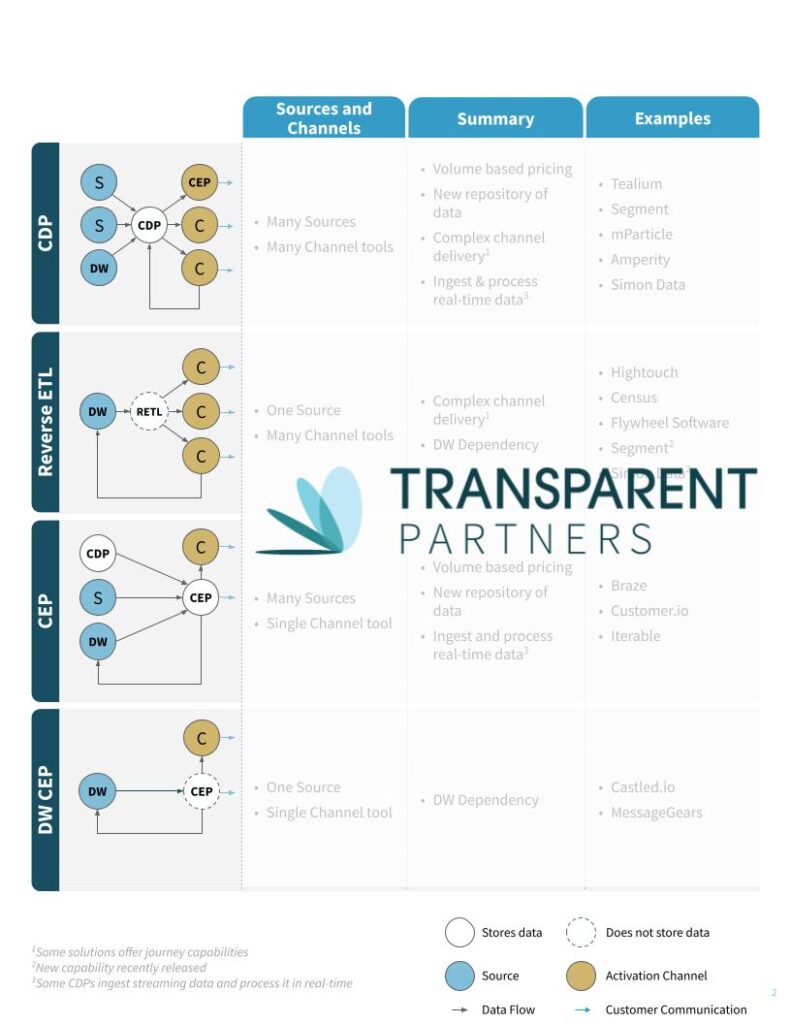The Evolving CDP Landscape
February 20, 2023The CDP space is getting more complicated.
The CDP landscape has always been a complicated space, and it is getting even messier. In the past five years, swaths of vendors have gravitated to the space, rebranding their product as a CDP. Most recently, Reverse ETL tools and composable CDPs complicate matters even more. They both claim to solve the shortcomings of the CDP. They tout these shortcomings as:
- Creating yet another new data repository
- Volume-based pricing
CDP’s most popular use case was to collect and connect disparate data into a holistic customer profile, but people argued that they were creating yet another data repository. Typically, new data repositories mean more expenses, more opportunities for privacy violations and data leaks, more headaches for IT organizations, and more tech for people to learn.
The volume-based pricing argument criticizes CDP’s pricing models that you either pay to load events or transactions into the CDP or pay for the volume of customers you put into them. This can be costly at scale and duplication of costs if the data already exists in a cloud-based data warehouse.
What is a CEP, and how do they differ from a CDP?
In addition to discussing CDPs, I want us to consider Customer Engagement Platforms (CEP).
CEPs are similar to CDPs because they create a 360 Customer profile and enable segmentation.
The main difference is in the activation space. CEPs and CDPs both allow you to activate an audience on paid channels. The CEP wants to be your singular tool for sending email, push, in-app, and SMS. Whereas the CDP lets you federate audiences to other tools to send emails, push notifications, and SMS. To be honest, the lines are blurring here, as some CDPs are morphing into CEPs and vice versa.
What are Reverse ETL tools?
Recently a new tool category has emerged called Reverse ETL. An important question is ‘Is Reverse ETL a tool or a feature?’ It has certainly been branded or marketed as a category of tool, but the CDP vendors are adding it as a feature to repel this new category. Hence, the CDP vendors are making Reverse ETL a feature and not a tool.
What is it? Simply put, it’s like the last mile of the CDPs. They allow you to create and activate audiences on multiple channels. The big difference is that, unlike a CDP, they don’t want to store your data in a new repository; they want to access it from your existing repositories and handle it in memory without storing or making a new copy of it.
A big watch out here is that if you need real-time use cases, refer to my previous blog post; you are now dependent on another upstream system to ingest, process, and make data available in real-time to the Reverse ETL tool.
What are composable CDPs?
Simply put, you build your own version of a CDP using different components. Vendors are building these components for you on platforms like Snowflake and then you can assemble them together to create a best-of-breed approach. We are not going to delve into this category of tools in this post.
The evolving CDP and CEP landscape
In the diagram below, I show the evolution of CDPs, Reverse ETL, CEPs, and DW CEPs.

Click here to download the image.
At Transparent Partners we believe this is how the landscape will evolve:
- CDP vendors will add Reverse ETL as a feature.
- Reverse ETL tools will need to offer the capability to ingest, process, and make data accessible in real-time; thus, they will need to copy CDP features.
- CEPs will need to offer the ability not to store data. In other words, they will evolve to be DW CEPs.
- Finally, DW CEPs will need to add the most compelling features of all the platforms that came before them.
In the end, the winner will be a Frankenstein of sorts. A platform that offers the best features of all the individual categories, a mixture of the CDPs, the Reverse ETL, the CEPs, and the DW CEPs.
We can help decipher the best path for you.
These platforms will continue to evolve and challenge one another. Determining the best path for you will depend on your current ecosystem of tech and your use cases. With us by your side, we will simplify this space and ensure that you are set on the right path for your specific needs.
Please use this link to schedule a free 30-minute consultation to discuss your situation.


